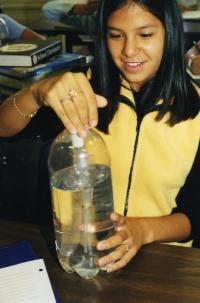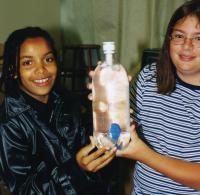Dennis Overbye wrote in the New York Times last week that “Science is not a monument of received Truth but something that people do to look for truth.” In a comment responding to this column about the resurgence of science under the Obama administration, a reader named Aaron writes:
Scientific thinking can and should be practiced by everyone, not just those who do science for a living. I'd love to see logical and critical thinking better integrated into the public school curriculum. I'd also like to see students learn how to formulate clear questions and design good experiments, rather than simply performing "canned" laboratory exercises. (How can something that has a predetermined answer be considered an experiment, anyway?) The ability to reason and to try one's ideas against reality are at the heart of the scientific endeavor, and, not coincidentally, essential to the nurturing and continued existence of democratic homo sapiens.
Overbye and Aaron have gotten to a core issue in science education. Science cannot be contained in a book. To be taught properly, it must be practiced. It is possible to teach the appreciation of music, but most schools choose to teach music by giving students instruments and allowing them to learn by practicing. Even though their early efforts may be painful squeals, the sweet notes will eventually come, and even the ones who do not achieve mastery know more than someone who merely has listened to a recording, or even attended a live concert.
The authors of the best science curricula understand this, and try to recreate the process of scientific discovery through an inquiry approach. Students need a chance to explore, especially with unfamiliar materials. Then they can begin to generate their own questions. As Aaron says, they need to try out their own ideas. That is when they begin to understand their own creative role in the scientific process. With practice and guidance, they can move beyond exploration and begin to learn the careful discipline of scientific investigation.

When I wanted to teach my students about buoyancy, I gave them Cartesian divers I had assembled using a soda bottle and eye dropper. I could have immediately provided them with a lecture explaining why the dropper dips when the pressure on the water is increased. But it was far more engaging for my students to get their diver and be asked to investigate themselves, using their powers of observation and experimentation to come up with their own ideas. They learned not only about buoyancy, but also about their own capacity to investigate the world around them.
Under No Child Left Behind, instruction in science has generally been downplayed, especially at the elementary level, because the lion’s share of a school’s score comes from language arts and math. Some have proposed that this could be fixed by giving science greater weight, and providing more frequent tests of science knowledge. Unfortunately, given the current approach to standards and assessment, I am afraid that will move us in the wrong direction.
Our states, (and California is as guilty as any) have laden down our science standards with lengthy lists of concepts and facts students must “know.” A little over a decade ago I worked helping develop a science curriculum. Even though we wanted to develop students’ ability to conduct scientific inquiries, our investigations tended to be carefully scripted, with predetermined questions and results. That is what you get when you have to address dozens of standards each semester. We produced something undeniably hands-on, but lacking in-depth scientific inquiry. And this is the nature of every curriculum that manages to meet state standards.
California standards include a strand focused on investigation and experimentation which actually includes some solid inquiry skills. If teachers focused on these, students would learn to record observations, generate hypotheses, and use the tools of science to investigate the natural world. Unfortunately, when it comes to the California Standards Tests that measure proficiency in science, the test blueprints reveal that only ten percent of the items focus on investigation and experimentation. Ninety percent of the questions ask students to recall facts and concepts, such as “Students know density is mass per unit volume.” This focus on facts tends to reinforce textbook-centered direct instruction.
The state has guidelines that require 25% of science curriculum to focus on hands-on activities. But hands-on is not the same as true scientific inquiry. Most textbook activities are cookbook recipes, with simple procedures followed by questions about what was observed and can be inferred as a result.

I am not suggesting students learn only what they can discover for themselves. We need to teach what has been discovered in the past, and what scientists are revealing about our world today. But we need a balance between teaching students what is known, and giving them the tools of science to make their own discoveries.
School reform has become intensely focused on accountability for results, and this has driven our curriculum and instruction towards that which can be measured on a multiple-choice test. But if these tests miss half the knowledge we truly value, as is the case with science, we may do more harm than good by increasing their emphasis. Our standards and our modes of assessment will need to change in order for us to truly challenge our students to become the scientists they can be.
What do you think? Are our science standards and tests missing the mark?